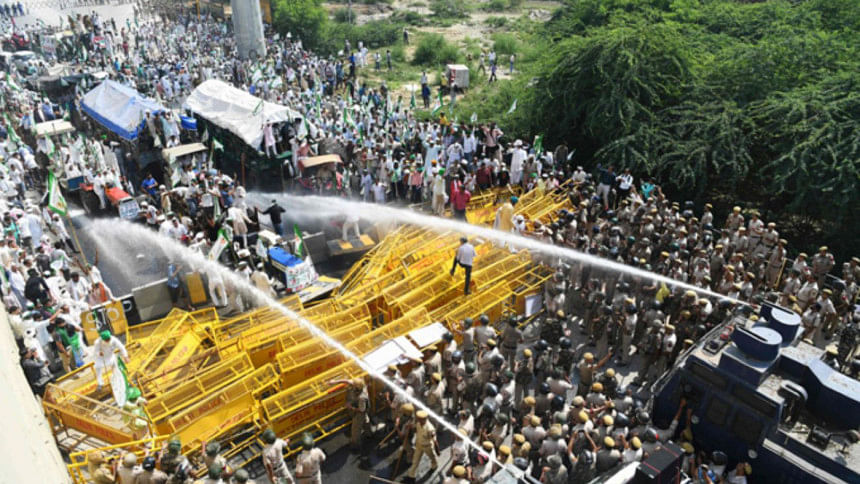Indian farmers in revolt

When Prime Minister Narendra Modi led his Hindu nationalist Bharatiya Janata Party (BJP) to a landslide victory in the 2014 general election, he promised to be all things to all voters, eloquently promising "achhe din" (good days) for India. One of his target audiences was farmers; the agriculture sector still accounts for 67 percent of employment, and he grandly promised farmers that his government would double their incomes by 2020. He swept their votes.
Today, as Modi seeks another term in a general election due before May this year, those promises are haunting him. Indian agriculture is in crisis. Farmers are in ferment. During Modi's tenure, the costs of inputs, and therefore of cultivation, have risen alarmingly, while prices for agricultural products, and therefore farm incomes, have stagnated or dropped. And, because government-guaranteed Minimum Support Prices (MSPs) have not been paid, farmers around the country are going broke.
It gets worse. When crops fail, many farmers and agricultural workers laid low by the crushing burden of debt (often incurred at usurious rates from rural moneylenders) commit suicide—as more than 11,400 did in 2016. That is the last year for which official data on farmer suicides is available, but media reports suggest the numbers have grown since then.
The biggest victims of the BJP government's neglect of agriculture have been the country's small and marginal farmers, as well as landless farm labour. These groups were dealt a body blow two years ago by Modi's thoughtless and foolhardy demonetisation scheme, which abruptly withdrew 86 percent of India's currency from circulation overnight. Daily wage workers, traditionally paid in cash, lost their jobs by the millions, because replacement currency had not been printed in adequate quantities. Small and micro enterprises in farm and market towns collapsed.
Modi is contemptuous of the previous government's Mahatma Gandhi National Rural Employment Guarantee Scheme (MGNREGS), which assured every poor rural household of a hundred days' paid employment per year. The scheme increased the purchasing power of the rural poor and reduced distress migration from the countryside, and the Modi government found it was the only lifeline available to support rural India amid the havoc wrought by its policies. Yet the government's failure to honour its MGNREGS bills on time has meant that many rural laborers have not received their benefits for months.
The cumulative impact of the Modi government's failures has been high levels of agrarian distress and unrest, with increasingly desperate farmers staging protests to sway the public and force the authorities to pay attention.
In 2017, frantic farmers from the southern Indian state of Tamil Nadu protested in the national capital, New Delhi, for more than a hundred days, with some stripping off their clothes in public to show they had nothing left. In March 2018, some 25,000 farmers marched in the BJP-controlled state of Maharashtra to demand debt relief, minimum support prices, and land rights. They grabbed headlines but little else; in late November, another 20,000 farmers marched in Maharashtra to demand compensation for the drought that had destroyed their crops.
On the last two days of November 2018, tens of thousands of farmers marched through New Delhi to the gates of parliament in a Kisan Mukti (Farmers' Liberation) March. Brought together by a network of more than 200 organisations from across India, the farmers, mostly peasants of modest means, clamoured for a familiar set of demands: debt relief and payment of MSPs for their produce.
The protesting farmers also demanded an emergency parliamentary session to discuss the agrarian crisis. This demand proved otiose, because Parliament was convened two weeks later anyway. Sadly, farmers' issues received minimal attention in the recent session, and the government failed to submit any proposals to alleviate the agrarian crisis.
But the countryside is seething, and the level of desperation on the part of farmers is mounting. During the summer of 2017, a protest in Mandsaur in Madhya Pradesh state (then ruled by the BJP), turned violent, and six farmers were shot and killed by the police.
With the Modi government seeming utterly clueless in the face of such protests, India's opposition parties have taken up the farmers' cause, and there is little doubt that it will be a major campaign theme of the anti-BJP coalition that hopes to wrest power from Modi this year. Within days of being sworn in, the Congress Party governments that won power in three states in December each announced the waiver of outstanding loans to farmers in their respective jurisdictions. While the BJP bleats that this is bad economics, the opposition has no doubt that it is good politics.
But loan waivers are only a temporary fix. The root causes of India's agrarian distress must be addressed. These include an arguably excessive number of people dependent on agriculture (two-thirds of the population produces 12 percent of GDP), uneconomically small landholdings (thanks to population growth and land reform), a broken agricultural credit system, government procurement policies that cause market distortions, and the failure to ensure MSPs. Many of the problems, ironically, are the result of earlier fixes gone wrong.
Whoever leads the government after the coming election will have to undertake a comprehensive overhaul of Indian agriculture. The current government's failure to confront the challenge is likely to ensure that it will not be Modi.
Shashi Tharoor, a former UN under-secretary-general and former Indian Minister of State for External Affairs and Minister of State for Human Resource Development, is currently Chairman of the Parliamentary Standing Committee on External Affairs and an MP for the Indian National Congress.
Copyright: Project Syndicate, 2019.
www.project-syndicate.org
(Exclusive to The Daily Star)

 For all latest news, follow The Daily Star's Google News channel.
For all latest news, follow The Daily Star's Google News channel. 



Comments